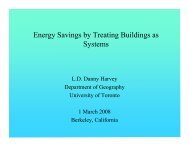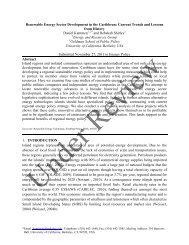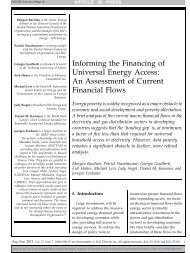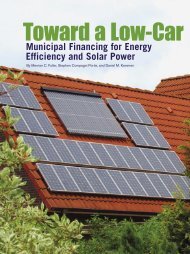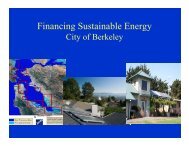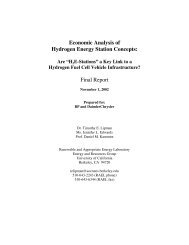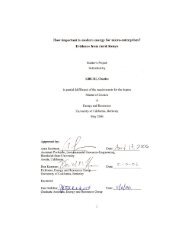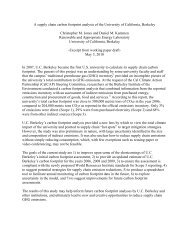Chapter 12 Energy for Development: Solar Home Systems in Africa ...
Chapter 12 Energy for Development: Solar Home Systems in Africa ...
Chapter 12 Energy for Development: Solar Home Systems in Africa ...
- No tags were found...
You also want an ePaper? Increase the reach of your titles
YUMPU automatically turns print PDFs into web optimized ePapers that Google loves.
Richard D. Duke and Daniel M. Kammen<strong>Africa</strong>. 13 SHSs account <strong>for</strong> roughly one-third of this, with the rema<strong>in</strong>der <strong>in</strong> telecommunications andvarious government and donor projects (e.g., water pump<strong>in</strong>g, schools, and health cl<strong>in</strong>ics). 14 This isequivalent to just 0.03% of total grid electricity generated.Project<strong>in</strong>g <strong>for</strong>ward to the year 2025, if off-grid PV sales <strong>in</strong>crease at 15% annually, then off-grid PVprovides 0.8% of total expected grid electricity generation by 2025 based on 3 GWp of <strong>in</strong>stalledcapacity. 15 This is an aggressive projection s<strong>in</strong>ce it is equivalent to provid<strong>in</strong>g a 50 Wp SHS <strong>for</strong> all 60million currently unelectrified <strong>Africa</strong>n households. Electrification ef<strong>for</strong>ts have often failed to keeppace with population growth <strong>in</strong> rural <strong>Africa</strong>, however, and average system sizes should <strong>in</strong>crease asSHS prices fall. Moreover, as off-grid markets beg<strong>in</strong> to saturate, grid-connected PV could grow tobecome a major factor <strong>in</strong> <strong>Africa</strong>n energy markets and some of the larger-scale companies <strong>in</strong>volvedwith provid<strong>in</strong>g rural solar <strong>in</strong>stallations might transfer their expertise to grid-connected markets as theyemerge.In sum, PV has the potential to contribute to the <strong>Africa</strong>n energy supply while provid<strong>in</strong>g criticaldevelopment benefits to rural populations and improv<strong>in</strong>g both the local and global environment.Growth <strong>in</strong> SHS and subsequent grid-connected markets will likely prove modest, however, withoutsusta<strong>in</strong>ed and aggressive public support. Assess<strong>in</strong>g the available policy options, and the desirabilityof this goal relative to other public priorities, requires further analysis.9. ACKNOWLEDGEMENTSThe authors wish to thank the anonymous reviewers <strong>for</strong> useful edits and suggestions.10. REFERENCESAbell, D.F. and Hammond, J.S. (1979) Strategic Market Plann<strong>in</strong>g. Englewood Cliffs: Prentice-Hall.Anderson, J. and R. Duke (2001). <strong>Solar</strong> <strong>for</strong> the Powerless: Electrify<strong>in</strong>g Rural <strong>Africa</strong> with the Sun (viewable atwww.pr<strong>in</strong>ceton.edu/duke).Argote, L. and Epple, D. (1990) Learn<strong>in</strong>g curves <strong>in</strong> manufactur<strong>in</strong>g, Science 247: 920-924.Arrow, K.J. (1962) The economic implications of learn<strong>in</strong>g by do<strong>in</strong>g. Review of Economic Studies 29: 166-170.Badiru, A.B. (1992). Computational survey of univariate and multivariate learn<strong>in</strong>g curve models. IEEE Transactions onEng<strong>in</strong>eer<strong>in</strong>g and Management 39 (2): 176-188.Banks, D. (1998). Off-grid electrification <strong>for</strong> the poor: constra<strong>in</strong>ts and possibilities, <strong>Energy</strong> & <strong>Development</strong> ResearchCentre.Boston Consult<strong>in</strong>g Group, Inc. (1972) Perspectives on Experience. Boston: The Boston Consult<strong>in</strong>g Group, Inc.Cody, G.D. and Tiedje, T. (1997) A learn<strong>in</strong>g curve approach to project<strong>in</strong>g cost and per<strong>for</strong>mance <strong>for</strong> photovoltaictechnologies. Presented to Future Generation of Photovoltaic Technologies NREL Conference held <strong>in</strong> Denver, Colorado,March 24-26.Colombier, M. and Menanteau, P. (1997) From energy labell<strong>in</strong>g to per<strong>for</strong>mance standards: some methods of stimulat<strong>in</strong>gtechnical change to obta<strong>in</strong> greater energy efficiency. <strong>Energy</strong> Policy 25 (4): 425-434.Duke R., Williams, R.H. and Payne, A. (<strong>for</strong>thcom<strong>in</strong>g). Accelerat<strong>in</strong>g residential PV expansion: Demand analysis <strong>for</strong>competitive electricity markets.Duke, R. (2002). Clean <strong>Energy</strong> Technology Buydowns: Economic Theory, Analytic Tools, and the Photovoltaic Case, Ph.D.Dissertation, Pr<strong>in</strong>ceton University.Duke, R. D., Graham, S., Hank<strong>in</strong>s, M., Jacobson, A., Kammen, D.M., Osawa, B., Pulver, S., and Walther E. (2000). FieldPer<strong>for</strong>mance Evaluation of Amorphous Silicon (a-Si) Photovoltaic <strong>Systems</strong> <strong>in</strong> Kenya: Methods and Measurements <strong>in</strong>Support of a Susta<strong>in</strong>able Commercial <strong>Solar</strong> <strong>Energy</strong> Industry, World Bank.13 Maycock (1996) suggests that <strong>Africa</strong> accounted <strong>for</strong> 10-13% of the global PV market <strong>in</strong> 1995. Assum<strong>in</strong>g 10% of the cumulative globalsales of 0.5 GWp implies cumulative PV <strong>in</strong>stallations <strong>in</strong> <strong>Africa</strong> of about 50 MWp by 1995. Cumulative global PV sales reached about 2GWp by the end of 2002 and roughly half of this was <strong>in</strong> off-grid <strong>in</strong>stallations (though the off-grid share has been dim<strong>in</strong>ish<strong>in</strong>g rapidly assubsidised grid-connected markets <strong>in</strong> <strong>in</strong>dustrialised countries have taken off). Assum<strong>in</strong>g <strong>Africa</strong> ma<strong>in</strong>ta<strong>in</strong>ed a 10% share of off-grid sales,this would imply additional PV <strong>in</strong>stallations <strong>in</strong> <strong>Africa</strong> of as much as 75 MWp: (2 GWp – 0.5 GWp) * 50% off-grid * 10% <strong>Africa</strong> share.14 This assumes there will be about 150,000 SHSs averag<strong>in</strong>g 25 Wp each <strong>in</strong> Kenya and another 500,000 SHSs scattered throughout the restof <strong>Africa</strong>, with an average size of 40 Wp, yield<strong>in</strong>g total SHS <strong>in</strong>stallations of 24 MWp. The Kenyan estimates are extrapolated from van derPlas and Hank<strong>in</strong>s (1998).15 This assumes electricity consumption <strong>in</strong>creases at 2% annually based on the GDP growth rate <strong>for</strong> <strong>Africa</strong> dur<strong>in</strong>g 1990-1997 and total offgridPV <strong>in</strong>stallations <strong>in</strong> <strong>Africa</strong> were about 16 MWp <strong>in</strong> 2002 (about 10% of the global off-grid PV market).



